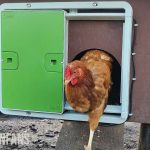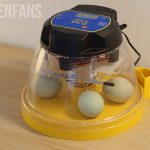All About Nesting Box Curtains

Nesting box curtains aren’t just about sprucing up your chicken coop. Ok, maybe just a little. But there are many more advantages to using curtains inside the chicken coop. Let’s find out what benefits there are and how to make them yourself!
Why use nesting box curtains?
- Seclusion
- Stops roosting on the edge
- Prevents egg eating
- Keeps eggs warm during winter
Seclusion
In nature, hens never lay eggs in plain sight. It prevents predators from finding the eggs or being disturbed while brooding. As this instinct is powerful, they’ll prefer the darkest and secluded place to lay eggs or start brooding. To make them feel comfortable, provide a private, dark nesting area where they feel safe.
Stops roosting on the edge of the nesting box
When introducing new hens to the chicken coop, they likely refuse to use the roosting perches at first and sleep on the edge of the nesting box instead. Nesting boxes aren’t meant for roosting.

Hens that roost inside or on the edge of nesting boxes can soil the inside bedding or surroundings of the nesting box. By covering up, or hiding, the area, your chickens won’t be interested anymore. You can train them by placing them gently on the roosting bar each night. They’ll get the hang of it in no time!
Prevents egg eating
Rule number one to prevent egg-eating habits is to collect the eggs regularly. But even in that case, tasty eggs in plain sight of other hens are a real temptation. The less visible the eggs are, the less likely they will be eaten or picked.
Egg eating is a tough habit to unlearn; once your chicken tastes a fresh yummy egg, chances are very high she’ll want more. But prevention is better and easier than cure, so blocking the view of freshly layed eggs helps this major problem.
Keeps eggs warm during winter
During cold and harsh winters, nesting box curtains can help to keep warmth inside the nesting box. This keeps eggs from freezing and cracking. Chickens are very cold hardy animals, so they don’t need the extra warmth, but if you don’t want broken eggs due to freezing temperatures, nesting box curtains can be a solution.

What fabric to use as a nesting box curtain?
Depending on how fashionable you want the nesting box to be, you can use any kind of fabric with any fancy print. It doesn’t matter; use whatever you have lying around in the house.
Nesting box curtains will probably get dirty quickly and need to be replaced quite often. Old sheets, clothes, pillowcases, and even a shower curtain can be easily transformed into a nesting box curtain. You don’t even have to bother washing the curtains. Just throw away the soiled fabric and replace it with a new one.
How to make a nesting box curtain?
Cut whatever fabric you want to use in the correct size. You can slice the material like a carwash curtain, so privacy is assured, but the hens have no trouble entering the nesting box. After cutting, sew the edges so the curtains won’t start to unravel and create a dangerous stringy situation. Hang the curtain using glue, drawing pins, or a leftover curtain rod.
If you have multiple nesting boxes, try out the curtain on one nesting box first, so your chickens can choose which one they prefer.

What color should a nesting box curtain be?
You can use whatever leftover fabric you have to create a curtain inside the coop. But when you have plenty of options to choose from, keep in mind that dark fabrics are better than light colors. Chickens prefer dark and secluded places to lay eggs, so translucent and light fabrics will make the nesting box environment too bright.
To sum things up!
Whether you want to use nesting box curtains is up to you. But they’re cheap and easy to make, and your hens will probably love them as they provide a dark and private place to lay eggs.
Further Reads
- Apart from nesting box curtains, you must consider options for nesting box bedding
- Nesting box bedding differs from chicken coop bedding
- Find out all about our most popular bedding type: Nesting Box Pads
- What to do if your chickens are broody






















